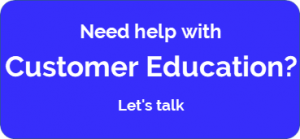I can Google® that! Why do I need training?
Reading Tara Bryan’s article, “Are You Trying to Compete with Google?” struck a nerve. As a Customer Education professional (trainer), I have always worried that I was boring people. I thought I was telling them things they already knew or could easily figure out. The reality is, that most people can figure things out. They also can find answers on the web or with help-guides. And yet, users may still need a well-designed training (and change management) program to use the tool effectively.
Customer Education to the rescue.
Most of my professional career has focused on software training. While the software I have taught has been user-friendly, I have found that many new users want a “tour-guide”. New users need context of what the application is, how it fits into their job, and how it makes their lives better.
Is Training the Answer?
Training is NOT always the answer. In the software world, users may be missing a step because it is not obvious. A tab might be better labeled or hard to find. In these cases, trainers can work with product development teams to make the necessary changes to the application.
In-App Product Tours
Many business applications now have in-app tours such as Pendo® or WalkMe®. These “tours” are instructions that overlay the application. They give suggestions of how to use a feature based on what the user has done. They are the answer to “meeting the user at the time of need.” They help understand how to use specific features within the software. And they are critical to measuring learning analytics. (But, more on that another time.) However, they are NOT the complete answer. And, unless they are implemented well, they can be annoying.
Is “Training” still necessary?
While product tours have revolutionized product onboarding, there is still a need for training that brings all the steps into context. Understanding how to use features is just one aspect of using a product. By contrast, a course, or “training” pulls the why’s and how’s of bringing functions together. It helps the user understand how the features help them do their jobs.
Training helps increase a users time to productivity by:
- Providing learners with a road-map of what to do when.
- Eliminating learners’ / users’ need to second-guess that what they are doing is the right thing to do at the right time.
- Accelerating users’ time to:
- Ramp-up use of the application
- Business productivity with the application
- Increasing learners’ sense of accomplishment. There is nothing like a sense of accomplishment when you finish something. Modern Learning Management Systems (LMS) have gamification tools. Learners can earn points, badges, and certificates which can be displayed on a user’s LMS and LinkedIn® profiles.
“Customer Education scales Customer Success with Onboarding.”
The definition of training has changed. It is no longer “the sage on the stage” where the expert shows off what they know. Training requires that the learner interacts with the information or the tool.
Customer Success professionals must have a hand in training their champions. But they can’t teach everyone. Customer Success professionals’ primary focus should be on strategy for implementing the software. Customer Education (CEd) scales Customer Success with onboarding.
Customer Education is a blend of Instructor-Led Training (in-person or virtual), and asynchronous training. A successful CEd strategy scales user onboarding. CEd helps customers use the application so easily that they no longer need to think about how to use the application.
Ultimately, customers’ success depends on great synergy between a company’s Customer Education and Customer Success.
Got questions about your Customer Education program? Book a free Customer Education strategy session.
Download PDF version.



